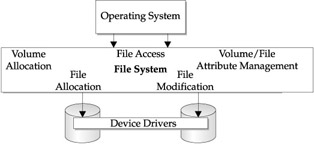File Systems
| |
From the most academic definition, the file system is a logical sequence of blocks on a storage media. Files are a basic construct of the operating system. With the exception of certain data (refer to relational databases further in this chapter), all data is kept in some type of file format. As such, it requires a system to maintain and manage the relationship with storage on behalf of the operating system. These file system functions are shown in Figure 8-1 and can be categorized in the following manner: allocation, management, and operations. These functions are described as follows :
-
Allocation File systems provide the capability to organize I/O devices into functioning units of storage.
-
Management File systems provide the activities necessary to track, protect, and manipulate data stored within the I/O devices.
-
Operations File systems locate logical sequences of data (for instance, a file) through various search methods depending on data recoverability and the sophistication of the system.

Figure 8-1: The components of a file system
Allocation
The file system allocates the two most important elements of the storage media, the volume, which defines the physical device, and its related attributes. Secondly, the files, which are collections of data, are accessible through some type of naming convention to the operating system and, subsequently, the applications are stored physically on the storage media. In todays environments, multiple products can make up these components. Accessible as add-ons to the basic components of the operating system, these products support two distinct but interrelated functions: file management and volume management. These products are available as recoverable, journal, or high-performance file systems and as enhanced or extended volume managers.
Volume Definition
Allocation of space within storage, especially in disks, begins with the initialization or formatting of the physical device itself. This is done by creating a volume that corresponds to a logical partition of space on a disk. Given the esoteric nature of volume initialization, volumes can be assigned to part of a disk or can span physical disks.
The activity of formatting defines the smallest unit of addressable space within the device and the creation of special files that will act as directories or catalogues for file allocation and access. In Microsoft operating systems, these are referred to as clusters and are mapped to the physical sectors of the physical disk. In UNIX, this is generally defined, given there are multiple UNIX variants, as a super block . Consequently, there exists a relationship between the file system allocation and the actual physical attributes of the disk, such as capacity and density. Both file system unitsclusters and blocks have an integral number of physical sectors. Therefore, large physical disks storing small files can become very inefficient when the lowest unit of storage is a cluster that utilizes multiple large sectors.
In addition, the overhead necessary to put the disk into activity (for instance, its formatting) explains the difference between formatted capacities of a drive versus unformatted capacity.
File Allocation
Once a volume is initialized , it is ready to store a file or logical sets of blocks. Files are allocated according to the attributes set with volume formatting. Given that, a file is allocated space through its smallest unit of measurement, which is the cluster or block. Files are tracked through special files that have been created with volume allocation. These master file tables (MFT), as they exist in Microsoft OSs (or inodes, as theyre referred to in UNIX systems), contain data about the volume, space attributes, and files stored within the volume.
Access to files starts here with the master file table or inode. Within these special files are indexing information, security access lists, file attribute lists, and any extended attributes that the file may have. Once the file has been created, these attributes are managed from these locations stored on the volume.
Management
The MFT, file allocation table, or super block-inode structures are increasingly being referred to as metadata. Metadata simply means information about data. As we discussed previously, the operating system requires a function to store and access data. One of these is the fundamental boot structure needed by the OS to initialize itself during a power up or restart sequence. In addition to the metadata files allocation during formatting, the process identifies and creates a boot file that becomes instrumental in locating the special system information needed during the OS boot processes.
Another important allocation during this process is the creation of a log file, thereby providing a recoverable file system, one that is required for enterprise-level operations. A recoverable file system ensures volume consistency by using logging functions similar to transaction processing models. If the system crashes, the file system restores the volume by executing a recovery procedure that utilized activity information stored within the log file.
In file systems, all data stored on a volume is contained in a file. This includes the file allocation tables and volume table of contents structures used to located and retrieve files, boot data, and the allocation state of the entire volume. Storing everything in files allows the data to be easily located and maintained by the file system, and a security attribute or descriptor can protect each separated file. If a particular part of the physical disk becomes corrupt, the file system can relocate the metadata files to prevent the disk from becoming inaccessible.
| Note | There is an important exception to the preceding statement that all data stored on a volume is contained in a file. The exception is the allocation of disks using raw partitions where an application will bypass the file system and manage the raw storage segments. This is common for many relational database products. |
| |
EAN: 2147483647
Pages: 192